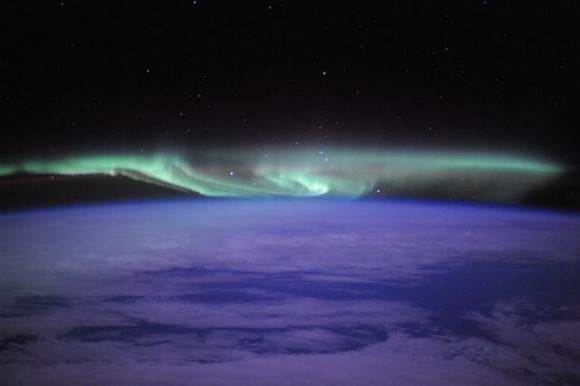NASA Earth Observatory | Image of the Day | 20 June 2010
Aurora As Seen from the Space StationAmong the views of Earth afforded astronauts aboard the International Space Station (ISS), surely one of the most spectacular is of the aurora. These ever-shifting displays of colored ribbons, curtains, rays, and spots are most visible near the North (aurora borealis) and South (aurora australis) Poles as charged particles (ions) streaming from the Sun (the solar wind) interact with Earth’s magnetic field.
While aurora are generally only visible close to the poles, severe magnetic storms impacting the Earth’s magnetic field can shift them towards the equator. This striking aurora image was taken during a geomagnetic storm that was most likely caused by a coronal mass ejection from the Sun on May 24, 2010. The ISS was located over the Southern Indian Ocean at an altitude of 350 kilometers (220 miles), with the astronaut observer most likely looking towards Antarctica (not visible) and the South Pole.
The aurora has a sinuous ribbon shape that separates into discrete spots near the lower right corner of the image. While the dominant coloration of the aurora is green, there are faint suggestions of red left of image center. Dense cloud cover is dimly visible below the aurora. The curvature of the Earth’s horizon (the limb) is clearly visible, as is the faint blue line of the upper atmosphere directly above it (at image top center). Several stars appear as bright pinpoints against the blackness of space at image top right.
Universe Today - 20 June 2010
Expedition 23 astronaut Soichi Noguchi took and shared so many amazing images during his 6-month stay on board the International Space Station, and I was a little worried that his return to Earth would result in a bit of a let-down in the space imaging department. I now see I had nothing to fear: Three new members of the Expedition 24 crew arrived at the ISS late last week and Doug Wheelock seems to have filled Soichi's shoes (or socks, since they don't wear shoes on the ISS) quite nicely. He posted two new images today on his Twitpic page that are nothing short of stunning. ... "A breath-taking masterpiece being painted in the sky over the South Pole. 'The Southern Lights'…like brush strokes from the Master's hand…" wrote Wheelock. Follow Wheelock on Twitter to get the latest images ...



